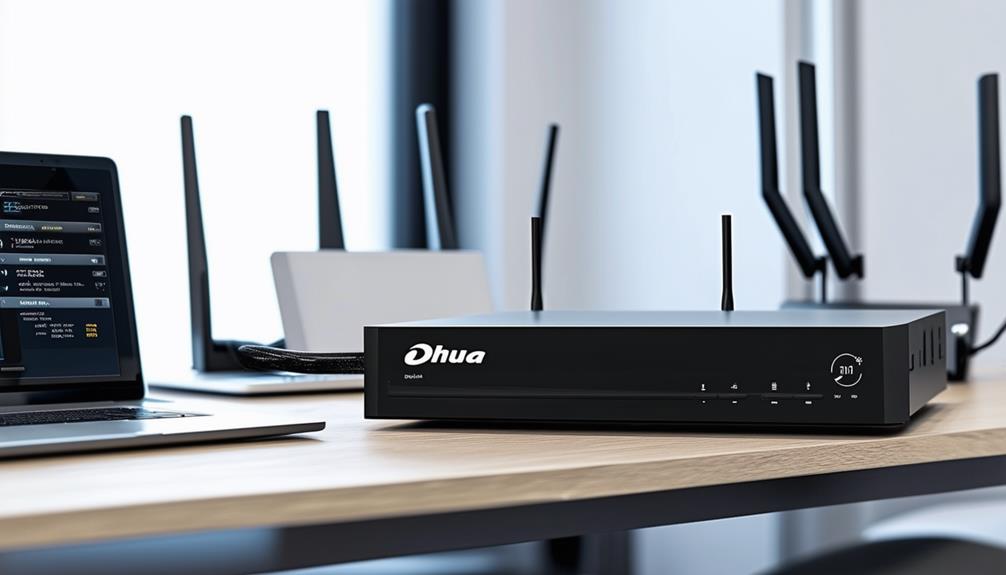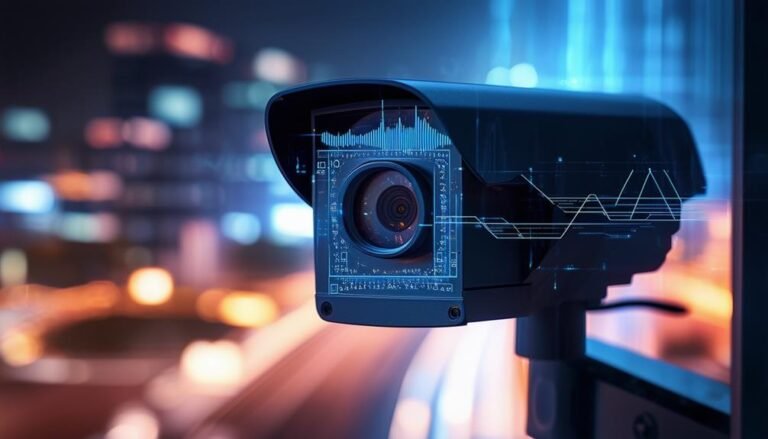To connect your Dahua NVR to the internet, start by gathering the necessary equipment like a stable router. First, power on the NVR and connect it to a monitor. Then, navigate to network settings and assign a static IP address, subnet mask, and your router’s IP as the gateway. Use an Ethernet cable to connect the NVR to the router. After saving your settings, restart the NVR to refresh the connection. Finally, test your internet connection using a ping command. Get ready to enjoy seamless remote access to your camera feeds, as there’s more to explore on setup options!
Gather Necessary Equipment
Before you plunge into connecting your Dahua NVR to the internet, it’s vital to gather the necessary equipment. You want to guarantee you have everything on hand, so you can make the process as smooth and efficient as possible. First off, you’ll need your Dahua NVR itself, which is the heart of your surveillance system. Without it, you won’t be able to access your camera feeds remotely.
Next, check your internet connection. Make sure you’ve got a stable router nearby. A good wired connection is often more reliable than wireless, so if possible, grab an Ethernet cable to connect your NVR directly to the router. This will help you avoid potential connectivity issues down the road.
You might also want to have a monitor or TV handy. It’s a great way to visually check your NVR settings during setup. Some users find it helpful to have a keyboard and mouse connected to the NVR, too, making navigation easier.
Lastly, don’t forget your power source. Make sure the NVR is plugged in and ready to go. Gather any necessary information like your network password and IP address, which will play a significant role in the next steps.
Configure Network Settings
Now that you’ve gathered everything you need, it’s time to configure the network settings on your Dahua NVR. This step is essential for guaranteeing that your NVR can communicate with your network and get you that freedom to monitor your security footage from anywhere. Let’s break it down.
First, connect the NVR to your monitor and power it on. Once it boots up, access the main interface. You’ll want to navigate to the “Network” settings. Here are some key elements to take into account while configuring:
- IP Address: Assign a static IP address to your NVR. This prevents it from changing, which is critical for consistent remote access.
- Subnet Mask: Typically, this will be set to 255.255.255.0, allowing your NVR to communicate within your local network.
- Gateway: Set this to your router’s IP address, usually something like 192.168.1.1 or 192.168.0.1.
- DNS Server: Use your router’s IP or a public DNS like Google’s (8.8.8.8) for better reliability.
Once you’ve filled in these details, save the settings and reboot your NVR. A quick test of the connection will help confirm everything’s set up correctly. With your network settings configured, you’re one step closer to enjoying the freedom of remote monitoring. Keep moving forward, and soon you’ll have your NVR fully online!
Connect NVR to Router
Connecting your Dahua NVR to the router is an essential step in establishing a reliable network connection. This connection allows you to access your security footage remotely, ensuring you have the freedom to monitor your property from anywhere. To get started, you’ll need an Ethernet cable. Plug one end of the cable into the Ethernet port on your NVR and the other end into an available LAN port on your router.
Once you’ve made the physical connection, it’s time to power on your NVR. After it boots up, navigate to the network settings menu using the NVR interface. Here, you’ll want to select the option for a wired connection, which should automatically detect your router. If it doesn’t, you may need to input some manual settings.
Ensure that the IP address assigned to your NVR is within the same range as your router’s IP. This allows for seamless communication. If you’re unsure of the router’s IP range, check the label on the router or its user manual.
After you’ve verified the settings, save your changes and restart the NVR. This process helps refresh the connection.
Lastly, confirm that the NVR shows a successful connection indicator on the screen. With everything in place, you’re now set up to enjoy the flexibility of monitoring your security system remotely, giving you peace of mind and freedom in your daily life.
Test Internet Connection
Now that you’ve connected your Dahua NVR to the router, it’s important to test the internet connection. Start by checking the network settings to guarantee everything’s configured correctly. Then, perform a ping test to verify that your NVR can communicate with the internet.
Check Network Settings
To guarantee your Dahua NVR is properly connected to the internet, it’s crucial to check the network settings. This step guarantees that your surveillance system operates smoothly, giving you peace of mind. Here’s how you can quickly verify your settings:
- Access the NVR Menu: Use your mouse or remote to navigate to the settings menu.
- Select Network Settings: Look for the network or internet configuration options to view your current setup.
- Check IP Address: Make sure your NVR has a valid IP address that fits within your network’s range.
- Verify Gateway and DNS: Confirm the gateway and DNS settings are correct, as these allow your NVR to communicate with the internet.
Taking a moment to double-check these settings can save you from future headaches. If everything looks good, you can feel confident that your Dahua NVR is ready to keep your property secure. Remember, being proactive about your network settings empowers you to take control of your surveillance needs!
Perform Ping Test
A quick way to guarantee your Dahua NVR is truly connected to the internet is by performing a ping test. This simple yet effective method lets you check the responsiveness of your device and confirm that it’s communicating with the outside world.
To start, grab a computer or smartphone that’s also connected to the same network as your NVR. Open the command prompt on Windows or the terminal on Mac. Type in the command ‘ping’ followed by the IP address of your Dahua NVR. For example, if your NVR’s IP is 192.168.1.10, you’d enter ‘ping 192.168.1.10’. Hit Enter, and watch the responses roll in. If you see replies with time values, your NVR is online and accessible. If you get “Request timed out” messages, something’s off.
Set Up Remote Access
To set up remote access for your Dahua NVR, you’ll first need to configure the network settings properly. Next, enabling DDNS services will help you maintain a stable connection, even if your IP address changes. Finally, you can use the mobile app to access your NVR from anywhere, making monitoring your security system a breeze.
Configure Network Settings
Setting up remote access for your Dahua NVR involves a few key steps that’ll get you connected to the internet quickly. First, you’ll want to access the NVR’s menu. From there, navigate to the network settings where you’ll configure important details to guarantee a smooth connection.
Here’s what you need to do:
- Select the right network type: Choose between DHCP or Static IP depending on your network setup. DHCP is easier for most users.
- Enter the IP address: If you’re using a Static IP, input the IP address, subnet mask, and gateway that your network uses.
- Set up the DNS: You’ll need to enter a DNS server address; Google’s (8.8.8.8) works well if you don’t have one.
- Save your settings: Don’t forget to apply the changes before exiting the menu.
Enable DDNS Services
After configuring your network settings, enabling Dynamic Domain Name System (DDNS) services is the next step for setting up remote access to your Dahua NVR. DDNS allows you to access your NVR over the internet using a domain name instead of a numerical IP address, making it easier to connect from anywhere.
Here’s a quick guide on how to enable DDNS:
| Step | Action | Notes |
|---|---|---|
| 1 | Log in to your NVR | Use your admin credentials. |
| 2 | Go to Network Settings | Find the DDNS section. |
| 3 | Select DDNS Provider | Choose from available options. |
| 4 | Enter your DDNS details | Include your domain name. |
Once you’ve filled in the required information, save the settings and restart the NVR. You’ll then be able to access your system remotely, enjoying the freedom to monitor your space from anywhere. Just remember to keep your login credentials secure to maintain your system’s integrity. With DDNS enabled, your Dahua NVR is now ready for remote access!
Use Mobile App
Now that you’ve enabled DDNS, you can easily set up remote access to your Dahua NVR using a mobile app. This means you can monitor your security feeds anytime, anywhere, giving you the peace of mind you deserve.
To get started, download the Dahua mobile app, like DMSS or gDMSS, from your app store. Once installed, follow these steps:
- Open the app and create an account if prompted.
- Add your NVR by entering the DDNS address, username, and password you set up earlier.
- Save the settings and wait for the app to connect to your NVR.
- Once connected, you’ll have access to live feeds, playback, and notifications right on your device.
With this setup, you’re no longer tethered to a physical location. Whether you’re on the go or lounging at home, you can keep an eye on your property. Embrace the freedom of remote access and enjoy the convenience of managing your security system with just a few taps on your smartphone. Now, you’ve got the tools to stay connected and secure, no matter where life takes you.
Troubleshoot Common Issues
Troubleshooting common issues with your Dahua NVR can feel challenging, but many problems have straightforward solutions. When you encounter connectivity issues or performance glitches, it’s crucial to identify the root cause. Below, you’ll find a helpful table that highlights common issues and their respective solutions.
| Issue | Symptoms | Solution |
|---|---|---|
| No Internet Connection | Unable to access NVR remotely | Check your router and cable connections. Verify the network settings are correctly configured. |
| Poor Video Quality | Choppy or pixelated footage | Adjust your bandwidth settings or check your internet speed. Consider lowering the resolution if necessary. |
| NVR Not Recognizing Cameras | Cameras show offline status | Confirm your cameras are powered on and connected to the same network. Restart the NVR if needed. |
| Frequent Disconnections | Intermittent access issues | Check for firmware updates for both the NVR and cameras. A reset might be required if problems persist. |
| Mobile App Issues | Unable to view live feed | Verify that the app is updated. Confirm that your mobile device is on the same network or has access to the internet. |
Frequently Asked Questions
Can I Connect Dahua NVR Wirelessly to the Internet?
You might be wondering if you can connect your Dahua NVR wirelessly to the internet. While some NVR models support Wi-Fi connections, most are designed for wired setups to guarantee stability and security. If you’re aiming for that wireless freedom, consider using a wireless bridge or adapter to connect your NVR to your Wi-Fi network. Just keep in mind that this may affect the overall performance and reliability of your system.
What Is the Default IP Address for Dahua NVR?
The default IP address for your Dahua NVR is typically 192.168.1.108. If you want to access it, just type that address into your web browser. Keep in mind that you might need to adjust your computer’s IP settings to be on the same subnet, usually something like 192.168.1.x. This way, you can freely navigate and configure your NVR without any hassle. Don’t forget to check your device’s manual for specifics!
How Do I Reset My Dahua NVR to Factory Settings?
If you want to reset your Dahua NVR to factory settings, start by locating the reset button on the device. Press and hold it for about 10 seconds until the NVR powers off and then turns back on. This process restores all settings to their original state, so make sure you’ve backed up any important configurations first. Once it restarts, you can set it up again as needed.
Is a Static IP Necessary for Remote Access?
When considering remote access, you might wonder if a static IP is really necessary. On one hand, it offers stability and easier access, like having a permanent home address. On the other hand, dynamic IPs can change, making it trickier to connect. If you value hassle-free access and want to enjoy the freedom of reliable remote viewing, a static IP could be the way to go, ensuring you’re always connected without surprises.
Can I Connect Multiple NVRS to One Router?
Yes, you can connect multiple NVRs to one router. It gives you the flexibility to manage various camera systems from a single access point. Just guarantee your router’s bandwidth can handle the data load. You’ll need to assign different IP addresses to each NVR to avoid conflicts. With proper setup, you’ll enjoy seamless surveillance across multiple locations without sacrificing performance. It’s all about maximizing your surveillance capabilities!



